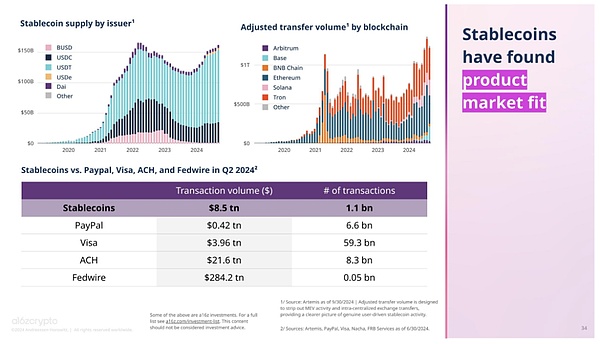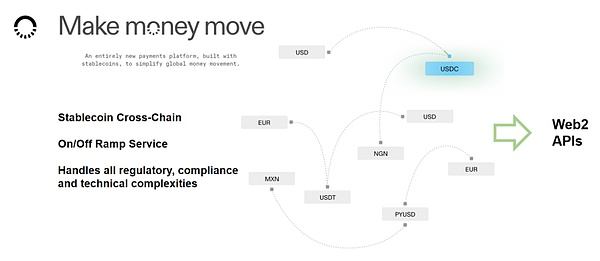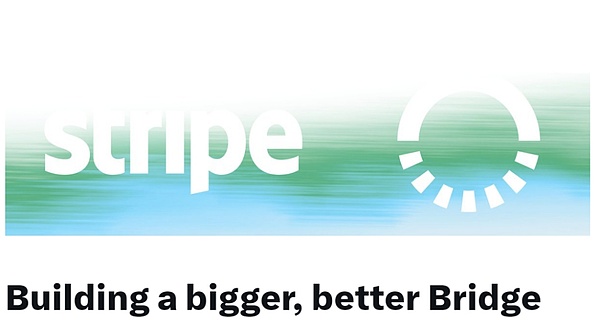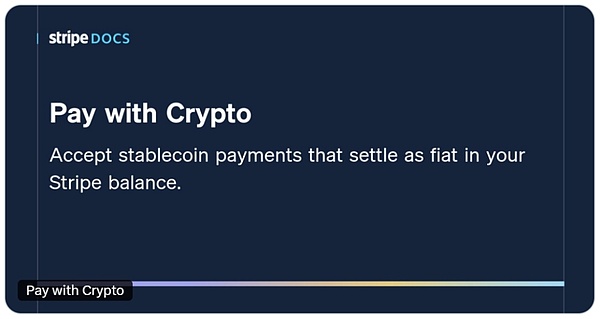For some, Stripe's $1.1 billion acquisition of Bridge, a stablecoin API service provider, seems to be a surprise move. But the fact is that stablecoins are sweeping the world, with a year-on-year growth rate of more than 50%, and its global transaction settlement volume is already more than twice that of Visa.
As the saying goes, a duck knows first when the river water warms in spring. As one of the three major payment giants in the United States, Stripe has finally made a big bet after its crazy attempts to Pay with Crypto this year. The acquisition of Bridge.xyz, a stablecoin API company that was only established for 2 years, for $1.1 billion created the largest acquisition deal in the crypto industry.
This article will start with stablecoins, look at the business logic of Bridge, and finally look at Stripe's acquisition logic.
1. The rise of stablecoins
The State of Crypto Report 2024, recently released by A16z Crypto, has made it clear that stablecoins have become one of the most obvious "killer apps" in the Web3 field. Thanks to the popularity of smartphones and the implementation of blockchain technology, stablecoins may become the greatest financial empowerment movement in human history.
Stablecoins make value transfer simple. Their quarterly transaction volume is more than twice that of Visa's $3.9 trillion, and trillions of dollars worth of assets are settled each year, fully proving their practicality. In addition, measured by daily active addresses, stablecoins account for nearly one-third of daily cryptocurrency usage, at 32%, second only to decentralized finance (DeFi), at 34%.

(State of Crypto Report 2024: New data on swing states, stablecoins, AI, builder energy, and more)
In addition, according to Visa's stablecoin report, the total supply of stablecoins is about $170 billion. They settle trillions of dollars worth of assets each year. About 20 million addresses on the chain conduct stablecoin transactions each month. More than 120 million addresses on the chain hold non-zero stablecoin balances. These figures all show that stablecoins are a currency that runs parallel to traditional financial infrastructure-five years ago it just started from close to zero.
Here are some crazy stablecoin statistics:
- Stablecoins are now the sixth largest purchaser of US Treasuries;
- 30% of cross-border remittances are conducted through stablecoins;
- Major companies such as Visa, PayPal, Square, Mastercard have stablecoin projects;
- SWIFT and some sovereign countries are exploring the utility of stablecoin payments.
- The use of stablecoins for non-crypto purposes is emerging, such as remittances, cross-border payments, payroll, trade settlements, and merchant settlements.
2. What is Bridge
Bridge was founded by entrepreneurs Sean Yu and Zach Abrams. It is a stablecoin API engine that provides software tools that help companies accept stablecoin payments. The two founders previously sold Venmo competitor Evenly to Block in 2013; Abrams is also a former senior employee of Coinbase.
Bridge's Orchestration API is an API that integrates stablecoin collection and payment into Web2's existing business. Bridge handles all compliance, regulatory and technical complexities.
Bridge's Issuance API can help users issue their own stablecoins and provide an investment option of 5% of US Treasury bonds to improve capital utilization.
This set of APIs, combined with Bridge's own 1) stablecoin cross-chain transactions, 2) fiat/cryptocurrency deposits and withdrawals, and 3) virtual bank accounts provided by Leed Bank, can help Web2 users use stablecoins for payment and collection more conveniently, and the user experience is smoother and more seamless.
Bridge said that using its API, funds can be transferred globally in minutes, stablecoin payments can be sent seamlessly, local fiat currencies can be converted into stablecoins, and US dollar and euro accounts can be provided to global consumers and businesses, allowing users to save and spend in US dollars and euros.
This is not a big innovation in essence, but it makes Bridge's products more convenient for Web2 users to interact with each other.

(https://www.bridge.xyz/#secSolution)
According to the Foresight News article "What is Bridge, which Stripe spent $1.1 billion to acquire?", Bridge has attracted many customers, including SpaceX. According to Fortune magazine, SpaceX uses Bridge to collect payments in different currencies in different jurisdictions and transfer them to its global treasury through stablecoins.
Bridge has also established partnerships with crypto companies such as blockchain network Stellar and Bitcoin payment application Strike to provide infrastructure for their own stablecoin payment functions. In addition, Coinbase has also adopted Bridge's services to support transfers between Tether on Tron and USDC on Base. According to statistics, Bridge has processed more than $5 billion in annual payments.
According to Forbes, Bridge had previously raised $58 million from investors, including a $40 million Series A round, when the company was valued at $200 million. Investors included Sequoia Capital, Ribbit Capital, Index Ventures, Haun Ventures and 1 confirmation. This time, the $1.1 billion acquisition price represents a 5.5x premium, the largest acquisition in Stripe's history, and the largest acquisition deal in the crypto industry to date.
The $1.1 billion acquisition price is not crazy, compared with the multi-billion dollar valuation of crypto protocols, and the only exit liquidity of crypto protocols is to sell useless governance tokens to the market.
3. Cooperation between Stripe and Bridge
The cooperation between Stripe and Bridge is essentially a continuation of the story of the rise of stablecoins. The integration of the two can further help the implementation of Stripe Pay With Crypto strategy. Stripe will be able to handle stablecoins more easily, making transactions more transparent and secure.

(x.com/Stablecoin/status/1848390039975469094)
Let's take a look at Bridge's latest official announcement:
"Bridge and Stripe will work together to accelerate the adoption and practicality of tokenized dollars, making it easier for everyone around the world to transfer, store and spend money.
When we launched our API 18 months ago, the world was very different from what it is now. Many people were questioning the practicality of the entire digital asset field, and stablecoins were also affected. Regulators, banks, and fintech companies were unable or unwilling to participate deeply in this new medium of exchange.
Stripe shares Bridge’s vision that our increasingly global world needs better money. We need money that can move across borders; that can be freely used by anyone in any country; and that can be sent for virtually nothing.
And, critically, we both believe that major changes in financial services won’t happen overnight. Change takes years of accumulation; continuous improvement of products and platforms, and ongoing trust with customers, regulators, and partners. ”
Fourth, Stripe’s Crypto layout
Previously, Stripe announced on October 10 that it would reconnect U.S. businesses to the encrypted payment gateway (Pay With Crypto), enabling U.S. businesses to:
1. Accept USDC and USDP (Crypto Payin) from more than 150 countries through Ethereum, Solana and Polygon;
2. Businesses/merchants can receive U.S. dollars (Crypto payouts);
3. Integration applies to checkout acquisition, element payment components, and payment intent APIs, and will soon be applicable to the company’s subscription function.
Stripe was in 2014 In 2017, Stripe became the first major payment company to offer Bitcoin payments. However, the feature was gradually reduced in 2018 due to a decline in demand caused by long confirmation times, high fees and price fluctuations at the time.
However, this is not the first time Stripe has integrated crypto services in recent months. In July this year, Stripe's EU company allowed users to buy cryptocurrencies such as BTC, ETH and SOL.
In June this year, Stripe also signed a cooperation agreement with Coinbase, Stripe incorporated Coinbase's Base Layer 2 into its cryptocurrency payment product, and at the same time, Coinbase allowed users to use Stripe's fiat-to-cryptocurrency onramp so that users can buy cryptocurrencies in Coinbase wallets (Stripe Fiat-to-Crypto Onramp).

V. Response to Paypal PYUSD
When I was writing "Web3 Payment Research Report: The All-out Attack of Industry Giants is Expected to Change the Existing Crypto Market Landscape" in October last year, I was still considering the specific utility and adoption of stablecoin payments. Now several payment giants have already joined the game.
After Payapl first issued its stablecoin PYUSD on Ethereum in August last year, it launched PYUSD on Solana in June this year. In addition to Paypal's own system, it is also actively promoting the developer ecosystem of PYUSD.
According to DeFilama data, in August this year, the volume of PYUSD on Solana accounted for 64% of the market share, while Ethereum accounted for only 36%. PYUSD's overall Market Cap reached 1 billion US dollars in August.
Payapl previously published a document clarifying the evolution of stablecoin payments towards Mass Adoption:
- Concept introduction brings cognitive awakening (Awareness through Introduction)
- Integration realizes payment utility (Utility through Integration)
- Stablecoin payments are ubiquitous (Ubiquity through Assimilation)
Obviously, it is currently in the second stage and is moving towards the third stage.
Another payment giant, Block (Square) led by Jack Dorsy is also a loyal believer in Bitcoin, holding 8,027 Bitcoins and also has many layouts in the Crypto field.
Sixth, Written at the end
As Anna @gizmothegizzer said, in the country of the blind, the one-eyed dragon is the king. In the field of encryption, the company with the most obscure API and the best connections may be the emperor. My first reaction is Tether, and Bridge may also be one of them.
We are just getting started.
Future mergers and acquisitions will be even crazier.
 JinseFinance
JinseFinance
 JinseFinance
JinseFinance Bernice
Bernice ZeZheng
ZeZheng Huang Bo
Huang Bo Alex
Alex Xu Lin
Xu Lin decrypt
decrypt Others
Others Others
Others Cointelegraph
Cointelegraph